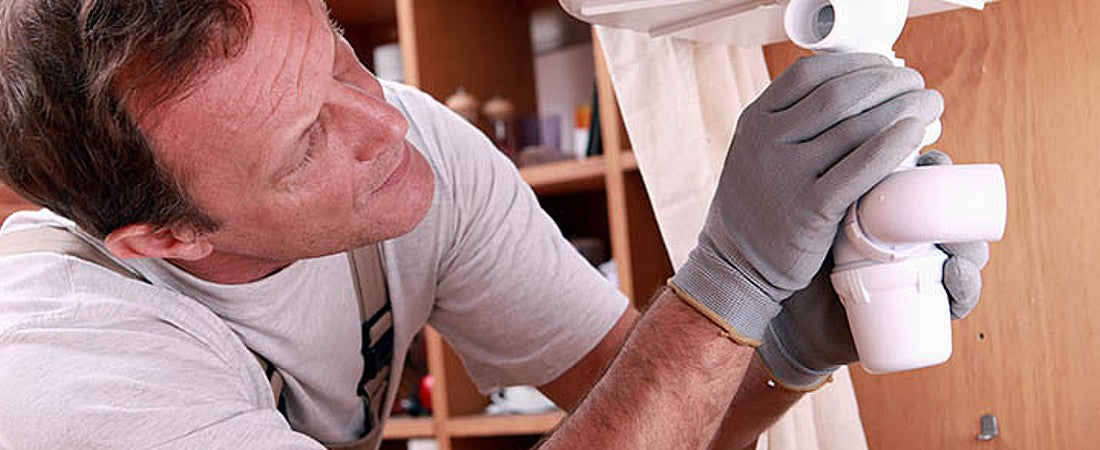
From Sink to Sewer: How Kitchen Wastewater Is Removed
|
|
Time to read 8 min
Written by: Taps UK
|
Published on
|
Time to read 8 min
Every time you run the tap or wash dishes, your kitchen sink drainage system carries wastewater away from your home. But how does it actually work? From the strainer in your sink to the pipes beneath the floor, each part of the system plays a role in moving water and waste safely to the sewer or septic tank. Understanding this process can help you spot problems early, prevent blockages, and keep your plumbing running smoothly.
Strainer Basket
The strainer basket sits in the plughole at the base of the sink. It catches food scraps and debris before they enter the pipes, helping to prevent clogs. Many baskets are removable, making them easy to empty and clean.
Strainer
The strainer is the fixed part installed directly into the sink’s drain opening. It forms a watertight seal between the sink bowl and the plumbing system while holding the strainer basket in place.
Tailpiece
The tailpiece is the straight pipe that connects the strainer to the P-trap. It provides a direct path for wastewater to leave the sink and flow into the rest of the drainage system.
P-Trap
The P-trap is the curved section of pipe located beneath the sink. Its shape traps a small amount of water, which blocks sewer gases from rising back up through the drain. It also helps catch small objects that may accidentally fall into the sink.
Wall Tube
The wall tube links the P-trap to the waste pipe inside the wall. This section carries wastewater away from the sink and into the home’s main drainage system, leading ultimately to the sewer.
Depending on your location, your kitchen sink drainage may connect to a municipal sewer system or a septic tank. In a municipal system, wastewater travels through a network of underground pipes that carry it to a sewage treatment plant. With a septic system, wastewater flows into a tank on your property, where bacteria break it down before the liquid is released into a drain field.
Keep in mind that plumbing layouts can vary. The exact design of your kitchen sink drain will depend on your home’s structure and local building codes. If you need detailed guidance, check your property’s blueprints or consult a qualified plumber for accurate information about your drainage system.
A kitchen sink drainage system includes several components designed to prevent bad odours and keep wastewater flowing smoothly.
A waste disposal unit can help break down food scraps, but it is not suitable for everything. Items such as large bones, fibrous foods like corn husks, grease, and non-food materials should never go into a disposal. Correct use and regular cleaning are essential to avoid clogs and extend the lifespan of the unit.
The sink strainer sits over the drain opening and catches solid waste such as food particles, debris, or utensils that may fall into the sink. By preventing these objects from entering the pipes, it reduces the risk of blockages and plumbing damage. If your sink is draining slowly, the cause may be a damaged seal or, more often, incorrect installation. For a detailed explanation, see our blog Why Your Kitchen Sink May Not Be Holding Water.
The P-trap is the U-shaped pipe fitted beneath the sink. It holds a small amount of water in its curve, creating a seal that blocks unpleasant sewer gases from rising back into your kitchen. This water barrier keeps odours under control while still allowing wastewater to flow freely into the drainage system.
A kitchen sink can develop unpleasant odours due to various factors. There are some common causes of kitchen sink smells found quite commonly in homes.
Food Waste: Food particles that accumulate in the drain or garbage disposal can decompose over time, producing foul odours.
Grease and Fat Buildup: Grease, oils, and fats that are poured down the drain can solidify and accumulate in the pipes, leading to odor-causing bacteria growth.
Clogs: Partial clogs or blockages in the drain can cause stagnant water to accumulate, which can emit unpleasant smells.
Failing Trap Seal: The trap beneath the sink holds a small amount of water that forms a seal, preventing sewer gases from entering your home. If the water in the trap evaporates, the seal breaks, allowing odours to escape
Now, let's discuss how a trap works and how to fix a failed trap seal.
A trap is a U-shaped pipe located beneath the sink. It is designed to hold water in its bend, creating a water seal. This seal prevents sewer gases from traveling back up through the drain and into your home.
If the water in the trap evaporates over time, such as when a sink is infrequently used, the trap seal can fail, resulting in odours.
Inspect the Trap
Locate the P-trap beneath your kitchen sink and inspect it carefully. Look for leaks, cracks, or damage that could be causing water to drain out and breaking the water seal.
Refill the Trap with Water
If the trap appears intact, pour water directly into the sink drain. This refills the trap, restoring the water barrier that prevents sewer gases and unpleasant odours from entering your kitchen. Make sure you add enough water to completely fill the bend of the trap.
Run Water Regularly
To maintain the trap seal, run water through the sink regularly, even if you don’t use it often. This prevents evaporation, keeps the water level stable, and stops foul smells from escaping the drainage system.
When to Call a Plumber
If you continue to experience trap seal failures or persistent odours despite these steps, contact a plumber. They can inspect your kitchen sink drainage system for hidden issues and provide a long-term solution.
Good Drainage Habits
Avoid pouring grease or fats down the sink.
Use a strainer to catch food particles and debris.
Clean the sink and trap area regularly to prevent build-up.
Practising these habits will help keep your kitchen sink drainage system clear, odour-free, and functioning effectively.
A waste disposal unit is an optional device installed beneath the kitchen sink to help manage food waste. Using a motorised grinding mechanism, it breaks down scraps into fine particles that are flushed away through the plumbing system. While convenient, waste disposals are not essential in every kitchen and are often chosen based on personal preference.
Together with the sink strainer and P-trap, a waste disposal unit helps keep your kitchen sink drainage system efficient and free from odours. The strainer catches solid waste, the P-trap creates a water seal to block sewer gases, and the disposal grinds food waste so it can flow easily through the pipes.
How a Waste Disposal Works
Operation – Activated by a wall switch or built-in button, the motor powers a grinding mechanism and shredding plate.
Grinding – Food waste is chopped into fine particles by impellers or blades, reducing it to a size suitable for flushing.
Flushing – Running water carries the ground waste through the plumbing system, preventing build-up inside the unit or pipes.
Waste Disposal Maintenance Tips
Proper Use – Only put suitable food waste into the unit. Avoid non-food items, large bones, fibrous foods (like corn husks), coffee grounds, grease, or fat.
Cold Water – Run cold water before, during, and after use. This helps solidify oils and fats, making them easier to grind and flush away.
Regular Cleaning – Use ice cubes and rock salt to dislodge debris and reduce build-up. Specialised disposal cleaning products are also available.
Citrus or Vinegar – Freshen the unit by running small citrus pieces through the grinder or flushing with vinegar, followed by water.
Professional Help – If you notice unusual noises, clogs, or ongoing issues, call a plumber to inspect and service the unit.
Extra Care for Your Plumbing System
For long-term freshness, products like Glisten Waste Disposal Cleaning Sachets can help eliminate odours and prevent grease build-up. Always follow the manufacturer’s instructions for your specific disposal model, as maintenance needs may vary
The strainer basket catches food scraps and debris before they enter the pipes, helping to prevent clogs. It should be emptied and rinsed daily, especially after cooking or washing up.
The P-trap holds a small amount of water that acts as a seal to block unpleasant smells from coming back up the pipes. If the sink hasn’t been used for a while and the P-trap dries out, simply run the tap for a few seconds to refill it.
Yes. Waste disposal units grind food scraps into tiny particles that can pass safely through pipes. For best results, run plenty of cold water while using the unit and avoid putting in fibrous or greasy waste that may cause build-up.
Every time you use your kitchen sink, a series of plumbing components—from the strainer basket and tailpiece to the P‑trap and wall tube—work together to carry wastewater safely away, either into a municipal sewer system or a septic tank.
The strainer basket catches solid debris, the strainer seals the opening, the tailpiece connects to the P‑trap, which traps water to block sewer gases, and the wall tube sends wastewater onward to the mains or treatment system.
Odours usually stem from issues like trapped food waste, grease buildup, partial clogs, or a dry trap seal. To combat these, the article recommends inspecting the P‑trap for leaks or damage, refilling it regularly, and flushing it with water to maintain the seal. Installing and properly maintaining a waste disposal unit can help manage food scraps, but only suitable waste should go through it—avoid fibrous materials, grease, or non‑food items. Regular cleaning, correct usage, and professional service when needed help keep the drainage system functional and odour‑free
The kitchen sink drain system relies on the strainer, tailpiece, P-trap, and wall tube to manage wastewater and block sewer gases.
Prevent odours by inspecting the P-trap, refilling it with water, and running the tap regularly to maintain the water seal.
Use waste disposal units properly, avoid unsuitable materials, and keep the system clean to prevent clogs and preserve functionality.
Taps UK is a prominent online retailer in the United Kingdom, specializing in a wide variety of kitchen and bathroom products. The company boasts a large selection of taps, sinks, and accessories from both well-known industry brands and its own exclusive lines, catering to a broad customer base that includes the general public as well as trade professionals like developers and builders.
Email Us: hello@tapsuk.com
Call Us: 01527 868500
Get all the latests news and offers from our team right to your inbox
Accepted payment methods:
© 2025 TAPS UK . All Rights Reserved.





